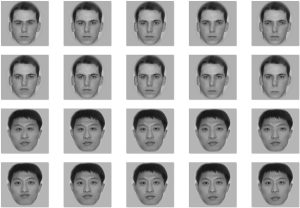7.2 The Cross-Race Effect

Figure 7.1. These are images used in studies on the cross-race effect. How easy would it be for you to detect differences between any two modified White or Asian American faces? [Image Description]
Culture also carries considerable implications for differentiating faces based on race. In the unit on Exposure and Perception (4.2), you learned about the other-race effect, which is the tendency for infants to spend more time with, prefer, and therefore become better able to differentiate faces of the genders and races they are most exposed to. In racially segregated societies, the other-race effect can continue into adulthood and lead to the cross-race effect, a memory error in which outgroup members are mistaken for one another due to an underdeveloped ability to differentiate outgroup characteristics. For instance, a White man with little exposure to Black faces may remember that he met a Black woman named Sandra. However, when he later sees Sandra alongside another Black woman he has also only met once, he may struggle to determine which one of them is Sandra. Because most people in the United States receive considerable exposure to White faces through media (for example, in movies), BIPOC tend to have less difficulty differentiating White faces.
Cross-race mistakes can carry considerable consequences (for one such consequence in the judicial system, see the NOBA unit on Eyewitness Testimony). Nevertheless, cross-race errors need not suggest one is racist; rather, these errors reflect how culture resides in our brains. In a highly segregated society, we may not automatically or naturally experience early interactions with outgroup members; thus, the foundation for learning differences between outgroup members may not be so strong unless we have some deliberate exposure efforts. Indeed, infants with early exposure to diverse faces show significantly reduced or even no difficulty differentiating outgroup members later in life (Hwang et al., 2021; Koch et al., 2024).
Video 7.1 “The Cross Race Effect” by That Explaining Channel.
Image Descriptions
Figure 7.1 Image Description: A grayscale image arranged in a 4-row by 5-column grid, showing 20 headshots of two men. The first two rows display five slightly varied images of the same man with light skin and short dark hair, each with a neutral facial expression. The bottom two rows show another man with medium skin tone, short dark hair, and similarly neutral expressions, also repeated five times per row. The images appear to be part of a facial recognition or psychological study, with uniform lighting and expression across each individual’s set. [Return to Figure 7.1]
Media Attributions
- Edited faces used for cross-race effect (other race effect) study © Zhe Wang, Paul C. Quinn, James W. Tanaka, Xiaoyang Yu, Yu-Hao P. Sun, Jiangang Liu, Olivier Pascalis, Liezhong Ge and Kang Lee is licensed under a CC BY (Attribution) license
